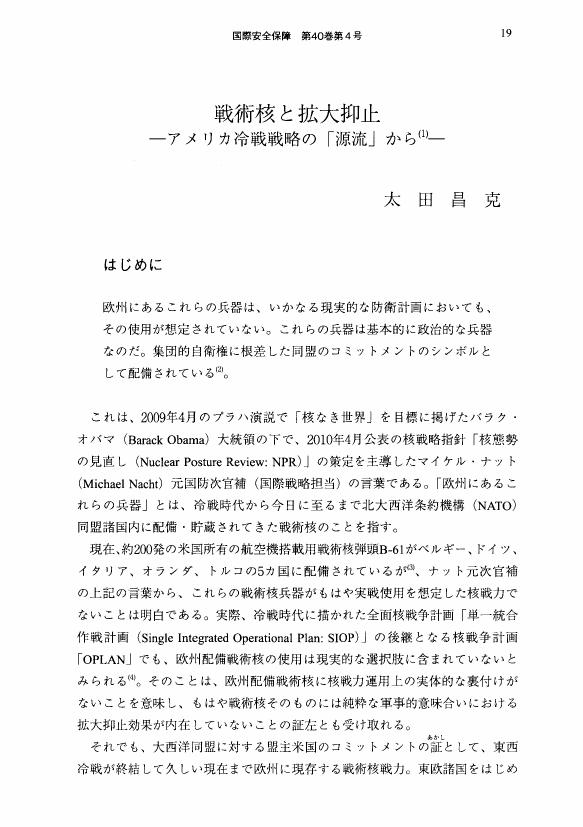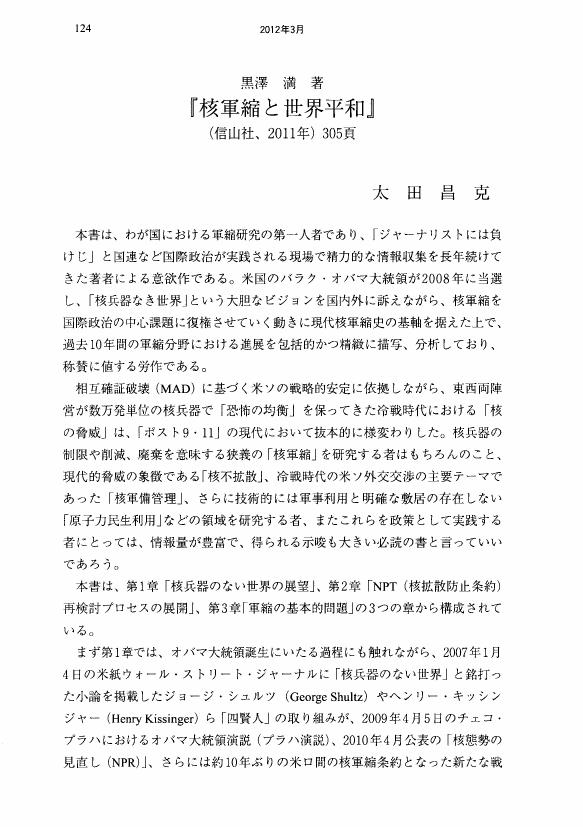1 0 0 0 OA 戦術核と拡大抑止 ―アメリカ冷戦戦略の「源流」から―
- 著者
- 太田 昌克
- 出版者
- 国際安全保障学会
- 雑誌
- 国際安全保障 (ISSN:13467573)
- 巻号頁・発行日
- vol.40, no.4, pp.19-35, 2013-03-31 (Released:2022-04-07)
1 0 0 0 OA 黒澤 満 著『核軍縮と世界平和』
- 著者
- 太田 昌克
- 出版者
- 国際安全保障学会
- 雑誌
- 国際安全保障 (ISSN:13467573)
- 巻号頁・発行日
- vol.39, no.4, pp.124-127, 2012-03-31 (Released:2022-04-14)
1 0 0 0 「日米核同盟化」の進展とその含意
- 著者
- 太田 昌克
- 出版者
- 一般財団法人 日本国際政治学会
- 雑誌
- 国際政治 (ISSN:04542215)
- 巻号頁・発行日
- vol.2021, no.203, pp.203_142-203_158, 2021-03-30 (Released:2022-03-31)
- 参考文献数
- 60
Since the Crimea crisis in 2014, the international nuclear order bed-rocked on the Nuclear Non-Proliferation Treaty (NPT) has become severely distressed due to lack of cooperation among nuclear stakeholders. Especially, stalling disarmament dialogue between the United States and Russia amplifies such a negative atmosphere. To be worse, the competitive nuclear-weapon powers have been beefing up their nuclear capability and sharpening their nuclear doctrines in recent years.The demise of the Anti-Ballistic Missile (ABM) Treaty in 2002 and the expiration of the Intermediate-Range Forces (INF) Treaty in 2019 have undermined the “strategic stability” which was established and maintained by the US and the Soviet Union, later Russia, through a series of nuclear arms-control negotiations during the Cold War.Behind these destabilizing scenes played by the former super-powers, China, another nuclear rising power, has steadily increased her strategic capability through deployment of new nuclear missiles and hypersonic weapons for the past decade. North Korea is another big nuclear challenge against regional stakeholders like Japan, South Korea and the U.S. that promises to provide strategic deterrence in East Asia.Giving a rough overview of the recent nuclear landscape shaped by these strategic trends, this paper mainly analyzes evolutions of the U.S.-Japan alliance influenced by U.S. nuclear policy, especially represented by each administrations’ Nuclear Posture Review (NPR), and deteriorating security situation in East Asia.For example, the Trump administration announced its own NPR in 2018 and broadened nuclear retaliation option against “non-nuclear strategic attack” which may include adversary’s cyber-attack on the U.S. nuclear command and control system. At almost the same timing of an announcement of Trump NPR, the Japanese Abe administration expressed a high evaluation of the NPR, because Japan strongly desired to strengthen the U.S. extended nuclear deterrence against the backdrop of on-going military crisis provoked by North Korea’s nuclear and missile tests.Based on exclusive interviews with current and former officials of the U.S. and Japan, the paper focuses on diplomatic process of the two allies for solidifying the nature of “nuclear alliance” through the Extended Deterrence Dialogue that started under the Obama administration in 2010. Differently from NATO, the U.S.-Japan alliance has not ever formalized any mechanism to share and operate U.S. nuclear weapons at the time of contingency. However, the paper sheds a light on how the U.S. and Japan have evolved their nuclear bond particularly for the past decade.
- 著者
- 佐々木 英基 柳澤 秀夫 太田 昌克 西土 彰一郎
- 出版者
- NHK放送文化研究所
- 雑誌
- 放送研究と調査 (ISSN:02880008)
- 巻号頁・発行日
- vol.71, no.6, pp.32-47, 2021
メディアにとって、国家が指定する“機密”にどう向き合うかは重要なテーマである。なぜなら、国民が“知る権利”を行使する場合、その権利は、メディアの取材および発表行為によって充足されることが多いからである。本稿は、2021年3月に開催したNHK文研フォーラム「メディアは“機密の壁”にどう向き合うか~豪公共放送への家宅捜索を手がかりに~」と題したシンポジウムの抄録を基本に、議論の内容をより深く理解するための情報を加筆したものである。このシンポジウムには、ジャーナリストと学者が参加し、国内外のメディアが“機密の壁”に直面した事例を題材に議論を展開した。議論の中では、“知る権利”、“国益”、“公益”、そして“国民の利益”等がキーワードとなり、メディアが直面する課題や、進むべき方向性が提示された。
- 著者
- 酒井 隆道 太田昌克 寺元 光生
- 出版者
- 一般社団法人情報処理学会
- 雑誌
- 情報処理学会研究報告マルチメディア通信と分散処理(DPS) (ISSN:09196072)
- 巻号頁・発行日
- vol.2002, no.85, pp.127-132, 2002-09-12
- 参考文献数
- 9
- 被引用文献数
- 2
近年,内容指向のメッセージ配送を行うContent-based network (CBN )がアプリケーション層ネットワークの一形態として着目を浴びている.CBN をグローバル環境において適用する場合,異なるオントロジーを有するエンドユーザ間におけるメッセージ配送を実現するための,オントロジー変換技術の確立が課題となる.本稿では,このようなオントロジー変換を実現するためのアーキテクチャを示し,フレーム形式のオントロジーモデルを対象としたオントロジー自動変換方法を提案する.A content-based network(CBN), that performs a content-based routing, is paid attention as a kind of an application-layer network in recent years. When we lay out the CBN at a global environment, we must establish an ontology transformation technique in order to realize the message routing between end-users of different ontologies. In this paper, we propose an ontology transformation architecture and an automatic ontology transformation method for the frame-based ontology model.
1 0 0 0 同調行動に基づく見解浸透モデル
人間社会では,個人は集団から影響を受けながら意思決定を行うと同時に,集団の一員として集団全体の意思決定に影響を及ぼしている.このような現象の1つである同調行動について,個人が多数派見解へ同調していく過程を再現する意思決定モデルを提案した.これは,集団から個人への影響のみを考慮したモデルである.本稿では,この意思決定モデルに個人から集団への影響を取り入れた見解浸透モデルについて述べる.本モデルは,個人間のミクロな相互依存関係によって,ある見解が集団に浸透し,マクロな共通見解が形成されていく過程を再現する.さらに,同じ見解を持つ人の継りに着目した見解の浸透状態の解析について述べる.

